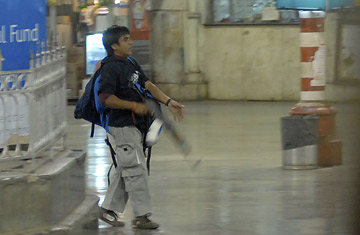
A gunman walks at the Chatrapathi Sivaji Terminal railway station in Mumbai
The disembodied voice was chilling in its rage. A gunman, holed up in the Oberoi Trident hotel in Mumbai (formerly Bombay), where some 40 people had been taken hostage, told an Indian news channel that the attacks were revenge for the persecution of Muslims in India. "We love this as our country, but when our mothers and sisters were being killed, where was everybody?" he asked via telephone. No answer came. But then he probably wasn't expecting one.
The roots of Muslim rage run deep in India, nourished by a long-held sense of injustice over what many Indian Muslims believe is institutionalized discrimination against the country's largest minority group. The disparities between Muslims, who make up 13.4% of the population, and India's Hindus, who hover at around 80%, are striking. There are exceptions, of course, but generally speaking, Muslim Indians have shorter life spans, worse health, lower literacy levels and lower-paying jobs. Add to that toxic brew the lingering resentment over 2002's anti-Muslim riots in the state of Gujarat. The riots, instigated by Hindu nationalists, killed some 2,000 people, most of them Muslims. To this day, few of the perpetrators have been convicted. (See pictures of the terrorist shootings in Mumbai.)
The huge gap between Muslims and Hindus will continue to haunt India's — and neighboring Pakistan's — progress toward peace and prosperity. But before intercommunal relations can improve, there are even bigger problems that must first be worked out: the schism in subcontinental Islam and the religion's place and role in modern India and Pakistan. It is a crisis 150 years in the making.
The Beginning of the Problem
On the afternoon of March 29, 1857, Mangal Pandey, a handsome, mustachioed soldier in the East India Company's native regiment, attacked his British lieutenant. His hanging a week later sparked a subcontinental revolt known to Indians as the first war of independence and to the British as the Sepoy Mutiny. Retribution was swift, and though Pandey was a Hindu, it was the subcontinent's Muslims, whose Mughal King nominally held power in Delhi, who bore the brunt of British rage. The remnants of the Mughal Empire were dismantled, and 500 years of Muslim supremacy on the subcontinent came to a halt.
Muslim society in India collapsed. The British imposed English as the official language. The impact was cataclysmic. Muslims went from near 100% literacy to 20% within a half-century. The country's educated Muslim élite was effectively blocked from administrative jobs in the government. Between 1858 and 1878, only 57 out of 3,100 graduates of Calcutta University — then the center of South Asian education — were Muslims. While discrimination by both Hindus and the British played a role, it was as if the whole of Muslim society had retreated to lick its collective wounds.
Out of this period of introspection, two rival movements emerged to foster an Islamic ascendancy. Revivalist groups blamed the collapse of their empire on a society that had strayed too far from the teachings of the Koran. They promoted a return to a purer form of Islam, modeled on the life of the Prophet Muhammad. Others embraced the modern ways of their new rulers, seeking Muslim advancement through the pursuit of Western sciences, culture and law. From these movements two great Islamic institutions were born: Darul Uloom Deoband in northern India, rivaled only by Al Azhar University in Cairo for its teaching of Islam, and Aligarh Muslim University, a secular institution that promoted Muslim culture, philosophy and languages but left religion to the mosque. These two schools embody the fundamental split that continues to divide Islam in the subcontinent today. "You could say that Deoband and Aligarh are husband and wife, born from the same historical events," says Adil Siddiqui, information coordinator for Deoband. "But they live at daggers drawn."
The campus at Deoband is only a three-hour drive from New Delhi through the modern megasuburb of Noida. Strip malls and monster shopping complexes have consumed many of the mango groves that once framed the road to Deoband, but the contemporary world stops at the gate. The courtyards are packed with bearded young men wearing long, collared shirts and white caps. The air thrums with the voices of hundreds of students reciting the Koran from open-door classrooms.
